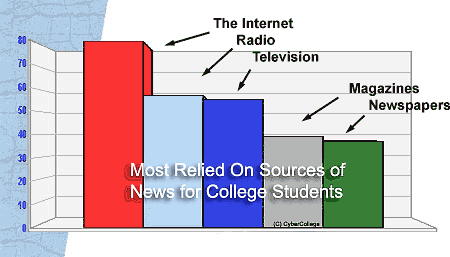The Print Media - 7 |
|
World Newspapers
Having seven of the word's top 20 newspapers, Japan leads the world in newspaper circulation. Japan also leans in number of readers per capita. Note from the listing below that China comes in second, and England a distant third. The Wall Street Journal in the United States is the only paper in the top 20.
USA Today ranks 23 in the world, the Los Angeles Times number 41, the New York Times number 43, and the Washington Post ranks number 73. In 2000, newspaper sales were up in 22 of the 46 countries in which data is available. At the same time, newspaper circulation in the United States showed a very slight decline in 2000--dropping to its lowest point since surveys began in 1987. Despite population gains in the United States, some 6.38 million fewer people buy a daily newspaper today than a decade ago.
Circulation of dailies in Canada increased slightly in 2002. They have risen steadily for four years, showing five-year gain of 3.4 percent. Even so, since 1915, the number of daily newspapers in Canada has been dropping. The introduction of radio in the Newspapers in Canada responded by increasing local news, sports, and national and international news. Surveys in Canada show that Canadians prefer television for international and national news, but rely on newspapers for local news. Circulation of weekly Canadian newspapers grew substantially in the late 20th century. In 1971, 3.8 million Canadians read a community newspaper; in 1999 that number topped 10.6 million.
Despite their dominance in world circulation, the circulation of Japanese newspapers actually dropped slightly in 2000 for the fourth consecutive year. Even so, this is a better showing than in many countries hit by a recession. India showed an exceptional sales increase of 20.2 percent in 2000. There are now 6.87 million more newspaper readers in India than in 1996, an increase of 28.7 percent. In China, newspaper sales are now over the 50 million mark, a 13 percent increase. At the same time, sales of dailies in Hong Kong have dropped 9.2 percent since 1996. The latest figures from Indonesia show that the number of daily newspapers has increased; but, at the same time, the circulation for newspapers was down in 2000.
The expansion of newspaper chains--i.e., ownership of a number of newspapers by a single company--has also increased worldwide. In Canada, about 70 percent of the total circulation is owned by five large corporations, four of which operate internationally. Only six cities in Canada are served by two or more independently owned newspapers. In the United States, where chains own most of the large city newspapers, there is also significant international control. The largest newspaper chain in the United States is Gannett Co., which owns some 90 newspapers with a circulation totaling more than 7 million worldwide. Hollinger International owns 105 daily newspapers in the U.S..
Electronic newspapers (on-line versions of city newspapers), which started in the late 1990s, have expanded to the point that now thousands of the world's newspapers are now Many of these on-line versions are the same as the newsprint versions. Most are free; however, they do carry advertising. Publishing on-line saves the publishers one of their biggest expenses: newsprint. The percentage of Americans getting news from the Internet at least once a week has more than quadrupled since 1996. Newspapers such as the New York Times and USA Today send free daily e-mail news summaries to anyone who wishes to sign up. (The next module contains links to major newspapers.) Note in the graph below that for college students the Internet leads all other sources of It would seem that high school and college students who get used to using the Internet for their e-mail, music, research, and coursework, would logically turn to this resource for news. In the next chapter we'll look at the current status of newspapers in the United States. |
|
|
|
To next module To
index © 1996 - 2005, All Rights Reserved.
|

 1920s, and television in the 1950s, knocked newspapers from their dominant position in the Canadian news media.
1920s, and television in the 1950s, knocked newspapers from their dominant position in the Canadian news media.  on the Internet. In North America there are more 1,000 newspapers online.
on the Internet. In North America there are more 1,000 newspapers online. news. This may explain some of the lack of popularity that newspapers have with young people.
news. This may explain some of the lack of popularity that newspapers have with young people.